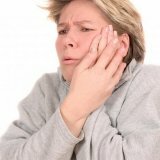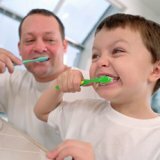Glossitis
 Glossitis is a disease of inflammatory genesis that appears under the influence of both endemic and allogeneic factors. In the correlation from the underlying cause, inflammatory and non-inflammatory glossitis are distinguished. Inflammatory glossitis begins under the influence of microbial flora and is an autonomous disease or manifestation of stomatitis. By the depth of penetration, the surface, deep and catarrhal are distinguished. Non-inflammatory glossitis is a manifestation in the oral cavity of somatic pathology. The development of any variant of glossitis has its own beginning and continuation, is distinguished by the clinic and the external form of the language. In the single variant it is rare. Among systemic diseases, the influence of autoimmune manifestations, digestive system diseases, allergies, hematopoiesis system, toxicosis with heavy metal salts is highly influenced. Exacerbate the condition in the oral cavity non-harmful addictions( smoking, drinking, eating a spicy meal).Inherited factors act indirectly. Glossitis affects mainly people after 40 years of age and childhood.
Glossitis is a disease of inflammatory genesis that appears under the influence of both endemic and allogeneic factors. In the correlation from the underlying cause, inflammatory and non-inflammatory glossitis are distinguished. Inflammatory glossitis begins under the influence of microbial flora and is an autonomous disease or manifestation of stomatitis. By the depth of penetration, the surface, deep and catarrhal are distinguished. Non-inflammatory glossitis is a manifestation in the oral cavity of somatic pathology. The development of any variant of glossitis has its own beginning and continuation, is distinguished by the clinic and the external form of the language. In the single variant it is rare. Among systemic diseases, the influence of autoimmune manifestations, digestive system diseases, allergies, hematopoiesis system, toxicosis with heavy metal salts is highly influenced. Exacerbate the condition in the oral cavity non-harmful addictions( smoking, drinking, eating a spicy meal).Inherited factors act indirectly. Glossitis affects mainly people after 40 years of age and childhood.
Causes of glossitis
Stomatitis, tooth ailments( caries and its aggravation), defects of periodontal tissues, fungal lesions cause the emergence of inflammatory glossitis that arise directly under the influence of the microbial flora of the oral cavity. With fungal transformations, the microflora is reconstructed into the mucous membrane of the tongue. Normally, fungi are present in the oral cavity, but Candidiasis glossitis is activated when the immunity decreases. This is possible for the elderly, children, HIV-infected or as a result of the therapy with antibiotics, glucocorticoids and cytostatics. Bacterial( staphylococci, streptococci, etc.) and viral microflora( mainly herpetic) are activated when the immunity decreases, traumatizing the tongue. In relation to the scale of penetration differentiate into superficial, catarrhal, deep, ulcerative, phlegmatic glossitis.
Glossitis, which is a manifestation of systemic pathology, differ in the ratio of the active factor. Infectious ailments of the skin and other systems( measles, rubella, scarlet fever) are visualized in the oral cavity. When visualizing the rash on the skin, the rash is also noted on the mucous capsule of the tongue( different types of rashes), combined with catarrhal glossitis. In the tertiary period of syphilis, interstitial glossitis is formed. Allergic diseases: atopic dermatitis, urticaria, contact allergy( on toothpaste, candy with dye, chewing gums, medications for oral cavity dissolving, rinses), the tendency to allergy forms desquamative glossitis, in addition, the development of catarrhal glossitis is possible. Desquamation of the tongue appears in the environment of the action of immunocompetent cells as a control over the damaging agents. There is a defect in the nutrition of the tongue, and autoantibodies appear that cause desquamation and keratinization.
Diseases of the vascular system( iron deficiency, B12-deficient, severe hemorrhagic( in view of significant blood loss) anemia) cause tissue hypoxia, which subsequently causes the development of atrophic and desquamative glossitis. With B12-deficiency anemia, Hunter's glossitis develops( variant of atrophic glossitis).Diseases of the digestive system: YABZH, gastritis, colitis, pancreatitis, hepatitis, dysbacteriosis, celiac disease, JAF, intestinal implantation, with predominant chronic course in the oral cavity at which the geographical language and the median rhomboid glossitis are common.
Glossitis of the tongue with desquamation originates in response to an increase and decrease in acidity, causing an early separation of the epithelium. With a long-term course of ailments of the digestive organs, deficiency in vitamin and hematopoietic exchanges is added. Autoimmune diseases: rheumatism, SLE, nodular periarteritis, collagenosis cause the formation of autoantibodies. Desquamative glossitis is formed in 25% of the occurrence.
Avitaminosis: lack of vitamins A, E, B, C( scurvy), folic acid. A Guntherian glossitis is formed. Folded glossitis as a variant of the anomaly of the formation of the language or congenital pathology. External impact: trauma of the tongue. The agent is distinguished by mechanical, thermal, physical. Occur with burns of the mucous membrane, bite of teeth, orthopedic constructions, defects of the mucous capsule with solid food, bones from meat of fish, birds. Use in the diet of spicy, spicy, hot food;Diseases of the nervous system, combined with convulsions and paralysis of the muscles of the face. Subsequently, trauma is likely the addition of microbes and formation after glossitis.
Pregnancy and lactation. With hormonal rebuilding of the body on a woman in the position is more stress on all organs and systems. Defit hypovitaminosis, digestive system diseases( due to the pressure of the enlarged uterus on the digestive organs), anemia, a decrease in immunity, a defect in the blood flow, which causes the appearance of glossitis, moreover, of any form. It is also possible in part to initiate glossitis with harmful habits( tobacco smoking, alcohol), endocrine changes, intoxication with salts of heavy metals, radiation poisoning.

glossitis: photo in an adult
Symptoms of glossitis
The glossitis of the tongue can flow without symptoms. Probably the primary diagnosis of the transformation of external language data. Patients may note the transformation of the visible variant and the color of the tongue: the appearance of flaking scales( geographical language), spots from bright red to pale or coloring of the tongue in pale or crimson color. It is also possible the presence of a deposit from gray and white, to brownish and bluish, for the most part taxation is noted. The tongue can be spotted, pink with bluish or dark red erythema. The size of the tongue changes: the patient feels a swelling. With an excessive increase in the amount of possible uncomfortable feeling with articulation and eating, traumatizing the tongue with teeth and orthopedic structures. In the tertiary period of syphilis in the formation of interstitial glossitis, with chronic trauma or with phlegmonous glossitis, in the depth of which multiple abscesses are noted, a deformation of the tongue occurs. The patient marks asymmetrical halves of the tongue, thin striated edges, prints of teeth and orthopedic structures along the edges.
It is also possible the appearance of aft, ulcers, plaque and rashes. Afta is an external epithelial injury. Ulcer is a lesion where penetration is deeper;And aphthae and ulcers are covered with plaque. In case of accidental removal of the plaque, patients may note bleeding.
Candidiasis glandus is characterized by an extensive dense coating of white-gray color, difficult to detach when scraping. When defects of deep layers of mucous tongue and villous epithelium are formed villous glossitis( "hairy tongue").Filiform papillae are extremely large, dark and horny. Further, the penetration of fungi into the bloodstream and the development of sepsis are likely, which is indicated jointly with local manifestations of common signs of intoxication.
A rash in the oral cavity is possible both singly and multitudinously. The contents of the rash differ from spots and seals to vesicles with a serous and purulent composition. Sometimes rashes combine, merging into plaques. The rash is for the most part indicated as a manifestation of the general pathology, combining with catarrhal glossitis( patients distinguish edema, redness, painful sensations, is calculated often with contact allergies).
Diseases of the system of blood formation in the oral cavity are marked by a gradient of color change in the mucosa and alignment of the appearance of the tongue. The tongue acquires a pale color, with a prolonged disturbance of the supply of oxygen to the tissues, the tissues of the tongue die and an atrophic glossitis is formed, possibly the formation of a geographical glossitis. With the initial manifestations of blood diseases in the oral cavity, paleness of mucous membranes and tongue is noted. Gunther's glossitis with B12-deficiency anemia is characterized by a raspberry tongue with a smooth smooth appearance( "lacquered tongue").Folded glossitis with intrauterine defects or as anomalies of the tongue is indicated by the phenomenon of folds, the increase in volume and the transformation of the form. The folds are distributed along the edges from the middle face, the deepest in the middle. Desquamative glossitis, the median rhomboid tongue begins with the ailments of the digestive organs. The latter is indicated by the consolidation of the middle part of the back of the tongue, the version of the oval or rhombus, a darkish shade.
In a correlation from hypovitaminosis of different groups, heterogeneous phenomena in the oral cavity are likely. From atrophic transformations( with anemia), strongly pronounced inflammatory manifestations( scurvy) before the violation of the passage of nerve impulses( vitamin B deficiency).The patient can also note burning, itching, discomfort with eating and articulation, which is determined by joining the infectious process or blocking the nerve endings. The patient can note the feeling of pain and at rest, increases with tension on the tongue. There is a violation of the touch of food and a change in taste sensitivity( caused by local transformations).Salivation increases, fetid breathing is felt, a rise in temperature is combined with pain in the head, weakness, a defect in sleep and appetite.
Glossitis in a child occurs sometimes without symptoms. Parents should examine the oral cavity and, when commenting on unusual language transformations( rashes, plaque, color change, drawing in the form of a "geographical map") seek advice. Also, glossitis in a child can be characterized by itching, burning, uncomfortable sensations.

glossitis: photos from the child
Diagnosis of the glossitis
At the initial stage, the glossitis of the tongue is probably not indicated, and, probably, is not diagnosed. The detection of changes in the oral cavity will help to establish a doctor on a physical examination or when dealing with another body disease. Begin diagnosing with the collection of complaints. Specify: what worries when it appeared, the sequence, the duration of the ailment that the patient used to relieve the condition( especially the emphasis on antibiotics, glucocorticosteroids, cytostatics - as a factor in the development of glossitis of the tongue).The general health of the patient and the phenomenon of health risk conditions are assessed. Somatic pathology is specified, if necessary, an appointment is made for admission to a specialist. Acceleration of pregnancy and lactation, the presence of TORCH-infections( herpes, cytomegalovirus, toxoplasmosis).Factors contributing to chronic traumatization of the language are identified: preference for harmful food, diseases of the nervous system, overestimation of fillings, inferior orthopedic devices. Clarify the phenomenon of dysbiosis( change in the composition of microflora), bad habits, what means of hygiene the patient uses.
The examination evaluates the symmetry of the face, skin, lymph nodes, opening the mouth. In visualization of the oral cavity, the condition of the mucosa and organs is established. There is a discoloration, plaque phenomenon, erythema, aphtha, erosion, rash, pustules, plaques. The phenomenon of bleeding gums and after removing the plaque from the language transformations. A change in the volume and shape of the tongue, the phenomenon of swelling or foreign inclusions is visualized. Factors of traumatization are established on the imprints on the mucosa( overestimation of seals, defective orthopedic devices).Diseases of teeth and periodontal tissues as carriers of microflora are revealed. In correlation with the scale of penetration, the glossitis of the tongue is differentiated into superficial( defeat of the mucous capsule of the tongue), catarrhal( lesion of the mucosa, the onset of edema), deep( the occurrence of abscesses), ulcerative( presence of a mucosal defect covered with bloom, removing bleeding of the wound), phlegmonousThe whole language, with the distribution on the tissues of the mouth and neck, with the appearance in the language of a lot of purulent foci).
These transformations are actively manifested in inflammatory glossitis, the source of infection of which is the microflora of the oral cavity. With non-inflammatory glossitis, the primary changes are not formed in the oral cavity and the examination should be performed by the physician corresponding to the lesion of the somatic system. For infectious reasons of development, the doctor selects additional methods of medical examination: bacteriological examination of the smear, histological examination of the tissues, a general blood test, biochemical blood test, blood test for HIV, syphilis and TORCH infections, feces analysis( for helminths - exclude helminth implantation and dysbiosis).Referral to related specialists: ENT doctor( inflammation of the VDP), gastroenterologist( symptomatology of the digestive system), immunologist-allergist( in anamnesis, allergy, regular colds, immunogram: with desquamative and contact catarrhal glossitis), hematologist( change of mucosa color, atrophy, A varnished surface), a therapist and rheumatologists( with collagenoses), an infectious disease specialist and a dermatologist( rashes on the skin).
Treatment of glossitis
Tactics of therapy depend on the etiological factor of glossitis. In inflammatory glossitis, which is the source of microbial agents of the oral cavity, the healing is directed locally. Professional cleaning of the dentition is carried out. Identified and cured carious teeth, ailments of periodontal tissues. Selection of purification means and training with control is carried out. Local traumatizing factors are eliminated( polishing of inflated seals, removal and replacement of defective orthopedic structures).Antiseptics for oral baths are used as a basis for anti-inflammatory action: Chlorhexidine 0.2-0.5%, Furacillin 1 tab. For 100 ml of water, Chlorophyllipt - are effective in bacterial agents, mediate in fungal transformation;Methylene blue aqueous solution( antimicrobial and antifungal effect, applicable in children's therapy, stains in blue).Herbal infusions( chamomile, sage), combined tinctures( Stomatophyte, Rotokan).Candidiasis glossitis is also well cured by Boer solution( inhibition of attachment of the fungus to the mucous capsule of the tongue and its spreading occurs), Sodium carbonate( baking soda - the cell capsule of microorganisms is destroyed).In severe course Flukanozol and Nystatin. Metragil Denta( gel-antiseptic with antibacterial activity).
In case of herpetic glossitis, the use of tablet forms of acyclovir, Herpevir;Cycloferon( increases the production of interferon).With a significant soreness of analgesics - blockade( Lidocaine 2%, Novocaine 2%).To stimulate local immunity - immunostimulants: Immunon, Lysozyme. With peeling, the presence of wounds, use the healing agents SDAP( Solcoseryl dental adhesive paste).In severe inflammatory glossitis, antibiotics are used: Cephalosporin series( Ceftriaxone), Macrolides( Rovamycin), Penicillins( Augmentin).With pathologies of other systems, the underlying ailment is cured. With hypovitaminosis: Retinol( replenishment of Vitamins A and E), Neuromultivitis( a combination of vitamin B), ascorbic acid, Calcium-D3-Nikamad. Before application of antiseptics, the plaque is removed. All infusions and antiseptics should be at room temperature. It is advisable to perform allergotest before use. The surgical procedure is started according to the indications: with a villous tongue( removal of the horny papillae), deep and phlegmonous forms of glossitis( open with abscesses and subsequent sanation).
Prevention of glossitis
The basis of preventive measures is the prevention of the origin and spread of ailments of the oral cavity and somatic pathologies. Medical examinations at the dentist for the detection of caries, complications, ailments of periodontal tissues, timely therapy, maintenance of dental hygiene and mucous membranes. The basis of cleansing the oral cavity is the correct technique for cleaning teeth and the necessary approach to hygiene( basic and supplementary).The main include toothbrush and toothpaste. Brush medium hardness, paste of preventive orientation. At transformation in structures of bodies of an oral cavity make correction of selection. By additional means include rinsers, dental floss, foam.
Examinations of generalists, if necessary, additional medical examinations. Correction of the diet: focus on vitamins and fiber-filled food: vegetables, fruits, greens, nuts. Consumption is gentle in proportion to the transformed mucosa( consistency of cream and sour cream, optimal temperature) and balanced by the combination( proteins, fats, carbohydrates, minerals).Prevention and exclusion of harmful addictions( smoking, alcohol, drug abuse).
It is recommended to provide not only the hygiene of the oral cavity, but also the hands, tools of general purpose, to exclude worm implantation. General hardening is recommended: daily sport, fresh air. Prevention of STIs( use of protection).Exclude or reduce contact with the allergen. With convulsive manifestations, use a kappa for the tongue, keep the tongue in the length of the fit. Vaccination against especially dangerous infections according to the vaccination schedule. Breastfeeding is mainly natural feeding, disinfection measures for toys, nipples, bottles, household items. Desquamative glossitis in a child in the interval of incision of milk teeth, in pubertal in boys and shortly before menstruation in girls does not mean treatment, since short-term manifestations.



